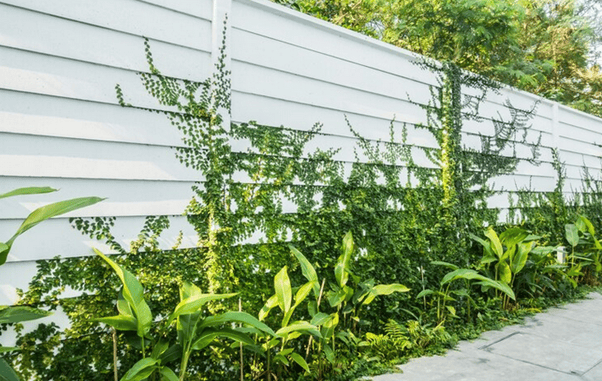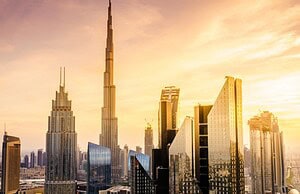Introduction
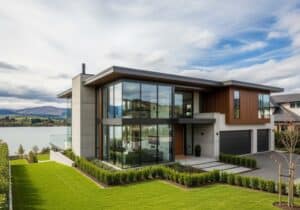
Securing our homes and businesses has become a top priority. Windows, often overlooked, are frequently the most vulnerable points of entry. They can be a weak link in any property’s defense. We understand this concern for safety and peace of mind.
High-security windows offer a powerful solution. They go far beyond basic glass. These advanced systems are no longer just for high-risk locations. They are now a vital investment for residential and commercial properties alike.
This comprehensive guide will explore high-security windows. We will uncover the threats they combat, from forced entry to extreme weather. We will compare innovative materials and cutting-edge technologies. Our guide will also detail key features, installation methods, and the many benefits beyond just protection. We aim to equip you with the knowledge to make confident choices. This will help protect your property without compromising on aesthetics or comfort.
Understanding the Threats: Why High-Security Windows are Essential
Windows are often the weakest link in a building’s defenses, making them prime targets for various threats. High-security windows are carefully engineered to counter these vulnerabilities, providing a robust barrier against a range of dangers.
The Anatomy of a Break-In
Burglars are opportunistic. They seek the easiest and quickest points of entry. In 2019, the FBI reported 1.1 million offenses of burglary in the U.S., with more than two in every three (62.8 percent) taking place at a residential property. The average monetary cost per offense was $2,661. These statistics underscore the pervasive nature of this threat. Criminals often target windows because traditional glass is easily shattered, and standard frames offer little resistance. The goal of a high-security window is to significantly increase the time and effort required for forced entry, acting as a powerful deterrent. Most burglars will abandon an attempt if it takes too long or creates too much noise.
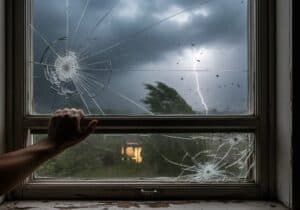
Beyond Burglary: Advanced Protection Levels
While preventing break-ins is a primary concern, high-security windows offer protection against a much broader spectrum of threats.
- Vandalism: From casual damage to targeted destruction, high-security glazing can withstand repeated impacts without breaking or allowing penetration, preserving the integrity of your property.
- Ballistic Threats: In an increasingly unpredictable world, ballistic protection has become a critical consideration for certain applications. High-security windows can be designed to resist various calibers of ammunition, offering vital protection in active threat scenarios. Glass-clad polycarbonate security windows, for example, can typically provide anywhere from UL 751 Level 1 ballistic resistance (resisting 9mm handgun attacks) to UL 752 Level 8 ballistic resistance (withstanding attacks from an AK-47 assault rifle).
- Blast Mitigation: For buildings in areas susceptible to explosions, whether accidental or intentional, specialized windows can absorb and dissipate blast energy, preventing dangerous fragmentation and structural damage.
- Extreme Weather: In regions prone to hurricanes, tornadoes, or severe storms, impact-resistant windows are crucial. They prevent flying debris from breaching the building envelope, protecting occupants and interiors from the elements.
These advanced capabilities mean high-security windows contribute to overall building security far beyond just preventing break-ins, offering peace of mind in diverse and challenging environments.
The Anatomy of a Secure Window: Materials and Glazing Technologies
The strength of a high-security window lies in its construction, combining robust frame materials with advanced glazing technologies. Understanding these components is key to choosing the right level of protection.
Frame Materials: The Foundation of Strength
The glazing is only as strong as the frame holding it. High-security window frames are engineered to resist significant force, often incorporating reinforced materials and sophisticated locking mechanisms.
- Steel-Reinforced uPVC: Offering excellent thermal performance and durability, uPVC frames can be internally reinforced with steel to provide improved structural integrity and resistance against forced entry. This blend balances security with energy efficiency.
- Aluminum-Clad Wood: Combining the aesthetic appeal of wood interiors with the low-maintenance and robust exterior of aluminum, these frames can also be reinforced to meet security standards.
- Solid Steel Frames: Known for their exceptional strength and slim profiles, steel frames are a top choice for high-security applications, offering superior resistance to burglary, bullet, and blast threats. Companies like SÄLZER Security specialize in such robust solutions. Steel windows offer design benefits similar to wooden windows combined with the advantages of steel, such as burglary and bullet resistance, noise reduction, and insulation.
- Timber Frames: While often associated with traditional aesthetics, timber frames can be engineered and reinforced with internal steel components to achieve high-security ratings, particularly for historical replication or specific architectural styles. Architectural Armour, for instance, manufactures security windows in both steel and timber.
Advanced Glazing Technologies Compared
The glass itself is the most visible component of a window and often the primary target. High-security glazing goes far beyond standard glass, employing various technologies to resist impact and penetration.
- Laminated Glass: This consists of two or more panes of glass bonded together with one or more layers of polyvinyl butyral (PVB) or SentryGlas Plus (SGP) interlayers. When impacted, the glass may crack, but the interlayers hold the fragments together, preventing a large hole from forming. Laminated security glass doesn’t shatter upon impact, like standard annealed glass and even tempered safety glass do. It offers good resistance against forced entry and can reduce noise.
- Polycarbonate: A thermoplastic polymer, polycarbonate is incredibly strong, lightweight, and virtually unbreakable. It is much more lightweight than laminated security glass and offers superior impact resistance compared to glass. However, it can be more prone to scratching and may yellow over time if not treated with UV-resistant coatings. Hammerglass, distributed by ProtectAll Inc. North America, is an example of a high-performance polycarbonate solution, with an 8 mm panel being as strong and durable as 24 mm armored glass. Hammerglass is certified as being of Security Class P8B, which corresponds to the highest protection class for security grilles and roller shutters.
- Glass-Clad Polycarbonate (GCP): This combines the best of both worlds. It features a layer of polycarbonate sandwiched between two layers of glass. The outer glass layers provide scratch resistance, UV protection, and the aesthetic clarity of traditional glass, while the inner polycarbonate layer delivers extreme impact and ballistic resistance. GCP offers high levels of protection, excellent clarity, and durability.
Here’s a comparison of these glazing types:
Feature Laminated Glass Polycarbonate Glass-Clad Polycarbonate (GCP) Protection Level Good against forced entry, holds fragments Excellent against forced entry, virtually unbreakable Superior against forced entry, ballistic resistance Clarity Excellent, similar to standard glass Good, can be prone to scratching/yellowing Excellent, similar to standard glass Weight Heavy Lightweight Moderate to Heavy (depending on layers) Cost Moderate High Very High Decoding the Standards: How to Choose Authentic European Security Windows
Choosing high-security windows requires more than just understanding materials; it demands familiarity with the standards and certifications that define their performance. These ratings provide a standardized way to compare products and ensure they meet specific protection levels.

Understanding European Resistance Classes (RC)
European standards, particularly DIN EN 1627, define resistance classes (RC) for windows and doors based on their ability to withstand forced entry attempts using specific tools for defined periods.
- RC1: Basic protection against physical violence (e.g., kicking, jumping). Resists for approximately 3 minutes.
- RC2: Resists opportunistic burglars using simple tools like screwdrivers, pliers, and wedges for at least 3 minutes.
- RC3: Protects against burglars using more robust tools like crowbars for at least 5 minutes.
- RC4: Resists experienced burglars using saws, striking tools, and battery-powered drills for at least 10 minutes.
- RC5: Designed to withstand highly experienced burglars using powerful electric tools like angle grinders for at least 15 minutes.
- RC6: The highest class, offering protection against highly skilled burglars using high-performance power tools for at least 20 minutes.
These classes provide a clear benchmark for the level of security a window offers. When considering Authentic European security windows, understanding these classifications is paramount for making an informed choice. For further insights into high-performance windows, you might explore resources on Euro windows.
Impact and Ballistic Ratings
Beyond forced entry, specific standards address impact and ballistic resistance:
- EN 356 Standard (P-ratings): This European standard classifies security glazing based on its resistance to manual attack using an axe or hammer.
- P6B, P7B, P8B: These are the highest classes, indicating resistance to repeated blows from an axe. For instance, Hammerglass SINGLE is certified in accordance with EN 356 as being of up to Security Class P8B, which is the security level insurance companies require for particularly exposed objects, such as goldsmiths or electronics companies. To qualify for P8B, a material must withstand 70 axe strokes.
- UL 752 Ballistic Levels: This American standard rates ballistic-resistant materials based on their ability to stop various types of ammunition. Levels range from 1 (resisting 9mm handguns) to 8 (withstanding multiple shots from an AK-47 assault rifle).
Performance Beyond Protection: Thermal, Acoustic, and UV Specs
High-security windows deliver more than just protection. They often come with improved performance features that contribute to overall comfort and efficiency.
- U-Value / R-Value: These metrics measure thermal performance. A lower U-value (or higher R-value) indicates better insulation and energy efficiency, leading to reduced heating and cooling costs.
- Solar Heat Gain Coefficient (SHGC): This measures how much solar radiation passes through the window. Lower SHGC values are desirable in hot climates to reduce heat gain, while higher values can be beneficial in colder regions.
- Sound Transmission Class (STC): High-security windows, particularly laminated and multi-layered glazing, excel at noise reduction. A higher STC rating means better soundproofing, creating a quieter indoor environment. Hammerglass ADD-ON, for example, offers noise reduction of 30 dBRw.
- UV Protection: Many security glazing options block a significant percentage of harmful UV rays. Certain types of security glazing can block out up to 99.9% of UV rays, protecting interior furnishings from fading and reducing skin exposure.
These additional specifications ensure that your security investment also improves the living or working environment.
More Than Just a Pane: The Holistic Benefits of High-Security Windows
High-security windows are a multi-faceted investment that extends far beyond their primary function of protection. They seamlessly integrate into modern architecture, offering aesthetic freedom, improved comfort, and superior efficiency.
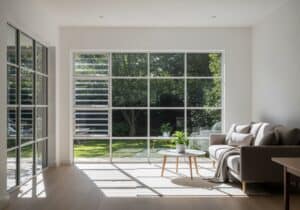
A Clear Advantage Over Bars and Shutters
Traditional security measures like bars or shutters, while effective, often come with significant drawbacks. They can compromise a building’s aesthetics, block natural light, obscure views, and even pose a fire hazard by impeding egress.
High-security windows, in contrast, offer a discreet yet powerful solution. They maintain the clean lines and open feel of modern design while providing robust protection. There’s no need to sacrifice natural light or unobstructed views. This blend of security and aesthetics is a key differentiator, making them a preferred choice for discerning homeowners and businesses. Hammerglass ADD-ON is recommended by insurance companies as an alternative to anti-theft grilles and roller shutters, highlighting this advantage. For homeowners looking to upgrade without compromising style, exploring options like those found on Top Security Doors or Secure House can be beneficial.
The Unexpected Perks: Energy, Quiet, and Comfort
The advanced construction of high-security windows inherently brings several additional benefits:
- Noise Reduction: The multiple layers of glass and interlayers in security glazing are excellent sound dampeners. This significantly reduces external noise, creating a quieter, more peaceful interior environment, whether from traffic, neighbors, or construction.
- Lower Energy Bills: The improved insulation provided by security glazing (often with low U-values) minimizes heat transfer. This means buildings stay warmer in winter and cooler in summer, leading to substantial savings on heating and cooling costs.
- Stable Indoor Temperatures: By reducing heat gain and loss, high-security windows help maintain more consistent indoor temperatures, improving overall comfort for occupants.
- Reduced Glare: Certain types of security glazing can reduce glare without blocking out natural light or reducing visibility, improving comfort for tasks like working on computers.
- Protection for Furnishings: The high UV protection offered by these windows prevents fading of carpets, furniture, and artwork, extending their lifespan and preserving their value.
These benefits demonstrate that high-security windows are not just a security upgrade but a comprehensive improvement to any property.
Installation, Aesthetics, and Applications
The effectiveness of high-security windows hinges not only on their design but also on proper installation and thoughtful integration into the building’s overall aesthetic.
Proper Installation for Peak Performance
Even the most robust security window will fail if improperly installed. The installation process for high-security windows is more demanding than for standard windows, requiring specialized techniques and reinforced fixings.
- New Construction Integration: In new builds, security windows can be seamlessly integrated into the structural design, allowing for optimal frame reinforcement and secure anchoring points.
- Retrofitting Existing Openings: For existing properties, high-security windows can be retrofitted. This may involve reinforcing the existing window opening or frame to ensure it can withstand the forces the window is designed to resist. Methods like overglazing or backglazing (mounting a security pane over existing glass) are options, or a full replacement of the existing glass with security glass.
- Multi-Point Locking Systems: These systems secure the window at multiple points around the frame when closed, providing superior resistance against prying attempts.
- Reinforced Hardware: Hinges, handles, and locks are all heavy-duty and tamper-resistant, designed to prevent manipulation or removal.
- Professional Installation: Due to the complexity and weight of these systems, professional installation by experienced technicians is crucial to ensure the window performs as intended and meets its certified security ratings.
Designing for Security Without Sacrificing Style
Modern high-security windows are a testament to how security and aesthetics can coexist. Manufacturers understand that protection should not come at the expense of design.
- Custom Shapes and Sizes: Whether for a grand arched window or a sleek, minimalist design, high-security windows can be custom-fabricated to fit virtually any architectural requirement.
- RAL Color Options: Frames can be finished in any RAL color, allowing them to perfectly match or complement the building’s exterior and interior design palette.
- Historical Replication: For properties in conservation areas or those with historical significance, security windows can be designed to replicate traditional sash styles or intricate patterns, preserving architectural integrity while upgrading protection.
- Slimline Profiles: Advanced engineering allows for robust frames with surprisingly slim profiles, maximizing glass area and natural light, a feature often desired in contemporary design.
- Modern Aesthetics: With options for integrated blinds, smart glass, and various finishes, high-security windows can improve a building’s modern appeal. For those interested in innovative window designs, exploring options like tilt-and-turn windows can provide both style and functionality.
Where are High-Security Windows Most Effective?
High-security windows are versatile and beneficial across a wide range of applications and environments:
- Luxury Residences: Protecting high-value assets and ensuring family safety without compromising on architectural grandeur. Custom Security Doors offers ballistic glass and custom security windows for homes.
- Commercial Storefronts: Guarding against smash-and-grab burglaries and vandalism, especially for businesses with valuable merchandise.
- Government Buildings & Embassies: Requiring the highest levels of protection against ballistic and blast threats.
- Schools & Universities: Enhancing safety for students and staff in an increasingly security-conscious world.
- Financial Institutions: Protecting against robbery and forced entry.
- Data Centers & Server Rooms: Securing critical infrastructure from external threats.
- Hospitals & Healthcare Facilities: Ensuring a safe environment for patients and sensitive equipment.
- Museums & Art Galleries: Protecting invaluable collections from theft and vandalism.
For more information on selecting the ideal security windows for your specific needs, particularly for Authentic European security windows, we recommend consulting specialists in the field.
Frequently Asked Questions about High-Security Windows
We often encounter common questions about high-security windows. Here, we address some of the most frequent inquiries to provide clarity and further insight.
Can security features be added to existing standard windows?
Yes, certain security features can be added to existing windows, though their effectiveness will vary compared to a purpose-built high-security window system.
- Window Security Film: Applying a clear, heavy-duty security film to existing glass can help hold shattered glass together upon impact, preventing easy entry and reducing injury from flying shards. 3M offers various safety and security window films that mitigate hazards from shattered glass.
- Aftermarket Locks: Installing additional, stronger locks like keyed locks, locking pins, or hinged wedge locks can improve the security of standard window sashes.
- Overglazing/Backglazing: In some cases, a layer of security glazing (e.g., polycarbonate) can be mounted over the existing glass, creating a multi-pane system.
- Limitations: While these methods improve security, they typically do not provide the same level of protection as a fully integrated high-security window system with reinforced frames and specialized glazing. The frame itself remains a potential weak point, and the overall system may not meet certified resistance classes. For optimal security, a complete replacement is often recommended.
Do high-security windows require special maintenance?
Generally, high-security windows are designed for durability and low maintenance. However, some practices can ensure their longevity and optimal performance:
- Regular Cleaning: Clean the glass and frames with mild soap and water, avoiding abrasive cleaners that could damage specialized coatings or polycarbonate surfaces.
- Hardware Checks: Periodically inspect locking mechanisms, hinges, and handles to ensure they operate smoothly and are free from wear or damage. Lubricate moving parts as recommended by the manufacturer.
- Seal Integrity: Check the seals around the glass and frame for any signs of degradation, which could affect thermal performance or water resistance.
- Manufacturer Guidelines: Always refer to the manufacturer’s specific maintenance instructions, as different materials and technologies may have unique requirements.
With proper care, high-security windows are built to last for decades, providing reliable protection.
How do high-security windows affect property value and insurance?
Investing in high-security windows can have several positive impacts on your property:
- Increased Property Value: Improved security is a significant selling point. High-security windows demonstrate a commitment to safety and quality, which can increase the perceived and actual value of your property. This is particularly true for luxury homes or commercial properties where security is a premium feature.
- Potential Insurance Premium Discounts: Many insurance providers offer discounts on homeowner’s or commercial property insurance premiums for properties equipped with advanced security features, including certified high-security windows. It’s advisable to check with your insurance agent about potential savings.
- Return on Investment: Beyond monetary savings and increased value, the peace of mind and protection against potential losses from burglary, vandalism, or extreme weather represent a substantial return on investment. The average monetary cost per burglary offense was $2,661, not including the emotional toll or potential loss of irreplaceable items.
Conclusion
High-security windows represent a pivotal evolution in building protection. They are no longer merely transparent barriers but sophisticated systems engineered to withstand a multitude of threats, from opportunistic burglars to ballistic attacks and extreme weather. We have explored the critical threats these windows address, the innovative materials and glazing technologies that define their strength, and the rigorous standards that certify their performance.
Beyond their formidable protective capabilities, high-security windows offer a wealth of additional benefits. They improve energy efficiency, reduce noise, block harmful UV rays, and maintain aesthetic integrity, often surpassing traditional security measures like bars and shutters. With customizable designs and robust installation methods, these windows integrate seamlessly into any architectural style, providing both peace of mind and an liftd living or working environment.
Choosing the right high-security windows is an investment in safety, comfort, and the long-term value of your property. By understanding the options and adhering to certified standards, you can make an informed decision that blends ultimate protection with uncompromising design.
For those seeking to improve their property with cutting-edge window solutions, including Authentic European security windows, we encourage you to explore the possibilities and consult with experts to find the perfect fit for your needs.



